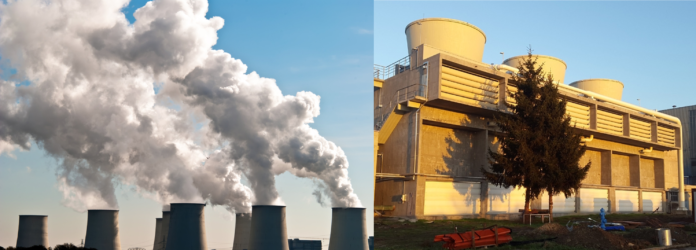Jane Marsh, a regular contributor here at the 21st Century Tech Blog, is an environmental journalist and Editor-in-Chief of Environment.co. The topic she writes about today is hybrid cooling tower technology. The first cooling towers appeared in the 19th century serving as condensers for steam engines.
Modern cooling towers date back to 1918 with their invention by Frederik van Iterson and Gerard Kuypers, two Dutch engineers who patented a design familiar to those who live near thermal and nuclear power plants. You can find them in use for other industrial applications as well. I will let Jane take over from here.
Cooling towers are heat exchangers that pull warmth from water used in industrial processes. The towers return cooled liquid to equipment such as HVAC systems (called chillers), petrochemical refineries, textile plants, wastewater treatment facilities and more.
Hybrid wet-dry cooling towers are a more advanced heat exchange version that combines dry and evaporative processes to minimize water and energy in industrial environments. Initially, they cost more to build but provide operational savings through reduced water consumption.
Water used in a manufacturing process or power station gets pumped through tubes that enter the dry cooling portion of the tower where heat exchange occurs. The water then travels to the wet cooling portion of the tower where it passes through a second heat exchange medium that usually contains evaporative fill to provide further cooling. If the technology only included the latter, the air leaving the tower would form a steam plume. In hybrid cooling towers, however, the air that leaves produces very little that is visible (see the pictures at the top of the page).
Why are hybrid cooling towers even though more expensive a better option for industries? The answer is they are more efficient and environmentally sustainable than traditional wet cooling towers. How so?
-
- Hybrid Towers Save Water – While wet cooling towers solely use water and dry towers use air, hybrid towers combine the best of both relying on the wet cooling elements at the hottest times of the year and dry cooling ones when it is colder. Hybrid towers use on average up to 50% less water than wet ones reducing water costs. A study that appeared in the journal, Thermal Science and Engineering Progress in 2019 showed even better results with water consumption savings of 63% over a year. One consideration when choosing between going hybrid or not, look at seasonal temperatures to see when wet versus dry cooling methods are optimal. Check out what local industries needing cooling towers are using which should help manage expectations when deploying a hybrid cooling system.
- Hybrid Towers Meet New Regulatory Requirements – Planning the design, installation and operation of cooling towers needs environmental impact considerations. For example, in May 2014, the U.S. Environmental Protection Agency created new regulations for wet cooling towers to install screens on intakes to protect endangered fish, shellfish and other marine life organisms from being killed. The regulation required 1,065 facilities to alter their designs. U.S. states, local jurisdictions, and other countries may also have regulations for the installation and operation of cooling towers. Many that face freshwater scarcity restrict wet cooling tower usage.
- Hybrid Towers Help Minimize an Industry’s Carbon Footprint – A recent market research report noted that sustainability was the primary factor encouraging decision-makers to adopt hybrid towers. They were seen as a means to minimize carbon footprints and provide more efficient and sustainable cooling. The report predicted market growth at a compound annual rate of 3.5% from 2022 to 2032.
- Hybrid Towers Can Use IoT-linked Sensors – The Internet of Things has come of age with sensors reporting to scorecards containing real-time data and statistics covering flow rates, temperatures and pressures. Automated sensors collect data, alert technicians to abnormalities and catch maintenance issues before they affect performance and add to operational costs.
- Hybrid Towers Reduce Chemical Usage – Wet cooling towers use many chemicals to treat the water, prevent corrosion, curb scaling, and inhibit microbial growth. These include phosphonates, polymers, azoles, silicates, zinc-based inhibitors, biocides and pH adjusters. Water residue containing many of these leftover chemicals can be dangerous to the environment. By adding water pretreatment before cooling, operators of cooling towers can produce a 50% ion reduction that minimizes water and chemical use.
A study published in 2022 looked at hybrid tower cycles for 215-megawatt high-end cooling loads. It showed that a combination of wet and dry cooling reduces energy, water and chemical usage. Although the dry cooling elements required a three times greater investment than the wet tower components, the sustainability and environmental benefits were seen to be worthwhile.









